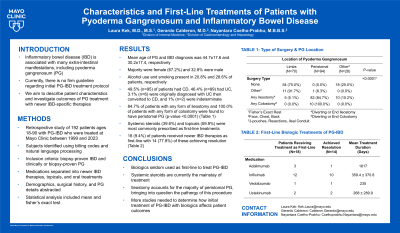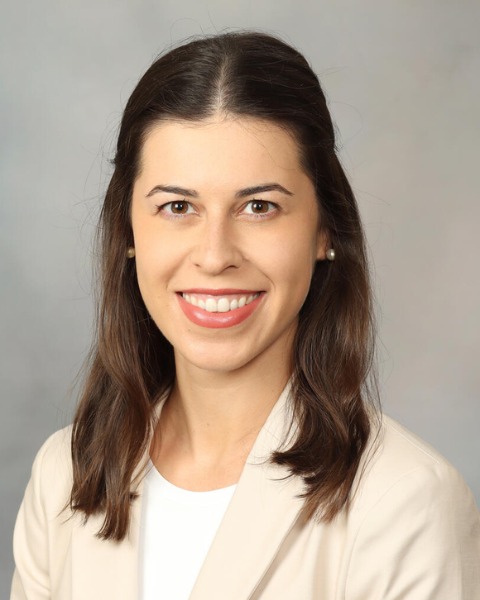Monday Poster Session
Category: IBD
P2622 - Characteristics and First-Line Treatments of Patients with Pyoderma Gangrenosum and Inflammatory Bowel Disease
Monday, October 28, 2024
10:30 AM - 4:00 PM ET
Location: Exhibit Hall E

Has Audio

Laura Kek, MD, MS
Mayo Clinic
Rochester, MN
Presenting Author(s)
Laura Kek, MD, MS, Gerardo Calderon, MD, Nayantara Coelho-Prabhu, MD, FACG
Mayo Clinic, Rochester, MN
Introduction: Inflammatory bowel disease (IBD) is associated with multiple extraintestinal manifestations, one of which is pyoderma gangrenosum (PG). This is an inflammatory skin disease characterized by painful ulcerations. We aim to describe patient characteristics and first-line treatments of patients with PG-IBD.
Methods: This is a retrospective, descriptive study of 192 patients with PG-IBD who were treated at any of the U.S. Mayo Clinic sites between 1999 and 2023. Patients were identified using billing codes and natural language processing. Data regarding demographics, alcohol use and smoking, types of abdominal surgical intervention, location of PG, and medication use were extracted. Medications were separated into biologics, topicals, orals, and IV (intravenous) formulations to evaluate first-line treatments at the time of PG diagnosis. Statistical analysis included mean and fisher’s exact test to calculate statistical significance.
Results: Mean age of PG diagnosis and IBD diagnosis was 44.7±17.6 and 30.2±17.4, respectively. 67.2% were female and 32.8% were male. Regarding race, 93.2% were White, 2.1% were African American, 2.1% were Asian, 0.5% were American Indian/Alaska Native, and 2.1% were unknown. Regarding ethnicity, 91.7% were non-Hispanic/Latino, 3.1% were Hispanic/Latino, and 5.2% were unknown. Alcohol use and smoking were present in 20.8% and 28.6% of patients, respectively. Regarding the type of surgeries patients received and their PG location (Table 1), 83.1% of patients with an end ileostomy were found to have peristomal PG (p-value < 0.0001). Systemic steroids (39.6%), topical steroids (31.3%), and topical tacrolimus or pimecrolimus (28.1%) were primarily prescribed as first-line treatments. Anti-TNF agents, Vedolizumab, and Ustekinumab were prescribed as first-line in only 9.4% of patients with Adalimumab and Infliximab accounting for 7.8% of cases. There were no cases of Upadacitinib, Risankizumab, or Certolizumab pegol as first-line agents.
Discussion: Our research aligns with current literature regarding PG and IBD diagnosis age, sex, race, and ethnicity. End ileostomy accounts for the majority of peristomal PG cases, which brings into question the pathergy of this procedure and its impact on the development of PG. Additionally, despite growing biologic use as first-line IBD treatment, biologics are seldom used to initially treat PG-IBD. More studies are needed to determine how initial treatment of PG-IBD with biologics affects patient outcomes.
Note: The table for this abstract can be viewed in the ePoster Gallery section of the ACG 2024 ePoster Site or in The American Journal of Gastroenterology's abstract supplement issue, both of which will be available starting October 27, 2024.
Disclosures:
Laura Kek, MD, MS, Gerardo Calderon, MD, Nayantara Coelho-Prabhu, MD, FACG. P2622 - Characteristics and First-Line Treatments of Patients with Pyoderma Gangrenosum and Inflammatory Bowel Disease, ACG 2024 Annual Scientific Meeting Abstracts. Philadelphia, PA: American College of Gastroenterology.
Mayo Clinic, Rochester, MN
Introduction: Inflammatory bowel disease (IBD) is associated with multiple extraintestinal manifestations, one of which is pyoderma gangrenosum (PG). This is an inflammatory skin disease characterized by painful ulcerations. We aim to describe patient characteristics and first-line treatments of patients with PG-IBD.
Methods: This is a retrospective, descriptive study of 192 patients with PG-IBD who were treated at any of the U.S. Mayo Clinic sites between 1999 and 2023. Patients were identified using billing codes and natural language processing. Data regarding demographics, alcohol use and smoking, types of abdominal surgical intervention, location of PG, and medication use were extracted. Medications were separated into biologics, topicals, orals, and IV (intravenous) formulations to evaluate first-line treatments at the time of PG diagnosis. Statistical analysis included mean and fisher’s exact test to calculate statistical significance.
Results: Mean age of PG diagnosis and IBD diagnosis was 44.7±17.6 and 30.2±17.4, respectively. 67.2% were female and 32.8% were male. Regarding race, 93.2% were White, 2.1% were African American, 2.1% were Asian, 0.5% were American Indian/Alaska Native, and 2.1% were unknown. Regarding ethnicity, 91.7% were non-Hispanic/Latino, 3.1% were Hispanic/Latino, and 5.2% were unknown. Alcohol use and smoking were present in 20.8% and 28.6% of patients, respectively. Regarding the type of surgeries patients received and their PG location (Table 1), 83.1% of patients with an end ileostomy were found to have peristomal PG (p-value < 0.0001). Systemic steroids (39.6%), topical steroids (31.3%), and topical tacrolimus or pimecrolimus (28.1%) were primarily prescribed as first-line treatments. Anti-TNF agents, Vedolizumab, and Ustekinumab were prescribed as first-line in only 9.4% of patients with Adalimumab and Infliximab accounting for 7.8% of cases. There were no cases of Upadacitinib, Risankizumab, or Certolizumab pegol as first-line agents.
Discussion: Our research aligns with current literature regarding PG and IBD diagnosis age, sex, race, and ethnicity. End ileostomy accounts for the majority of peristomal PG cases, which brings into question the pathergy of this procedure and its impact on the development of PG. Additionally, despite growing biologic use as first-line IBD treatment, biologics are seldom used to initially treat PG-IBD. More studies are needed to determine how initial treatment of PG-IBD with biologics affects patient outcomes.
Note: The table for this abstract can be viewed in the ePoster Gallery section of the ACG 2024 ePoster Site or in The American Journal of Gastroenterology's abstract supplement issue, both of which will be available starting October 27, 2024.
Disclosures:
Laura Kek indicated no relevant financial relationships.
Gerardo Calderon indicated no relevant financial relationships.
Nayantara Coelho-Prabhu: Iterative Health – Advisory Committee/Board Member.
Laura Kek, MD, MS, Gerardo Calderon, MD, Nayantara Coelho-Prabhu, MD, FACG. P2622 - Characteristics and First-Line Treatments of Patients with Pyoderma Gangrenosum and Inflammatory Bowel Disease, ACG 2024 Annual Scientific Meeting Abstracts. Philadelphia, PA: American College of Gastroenterology.
